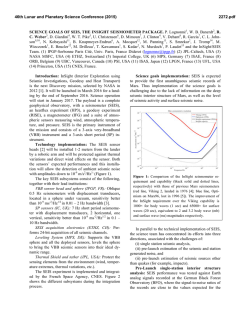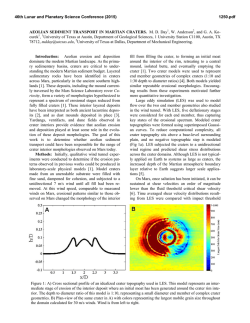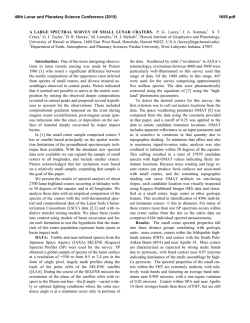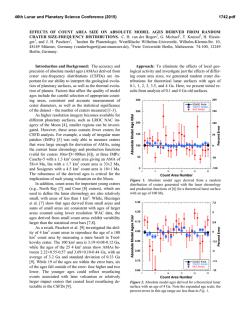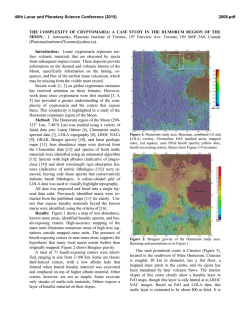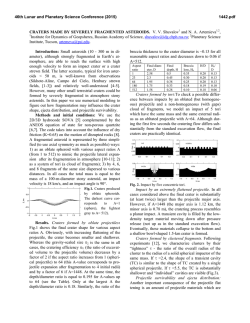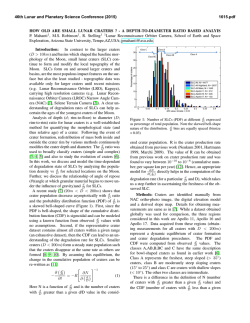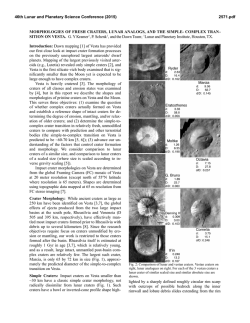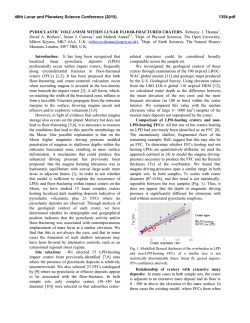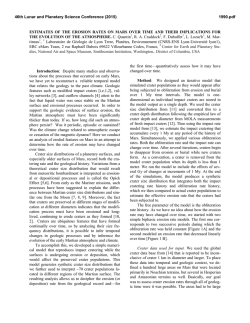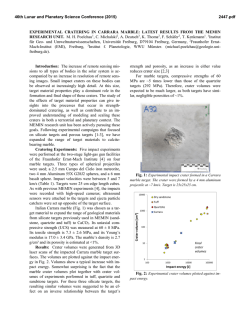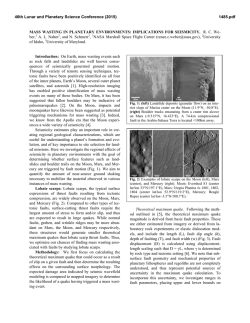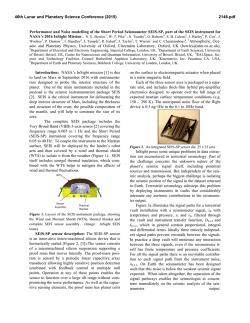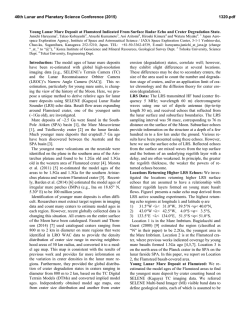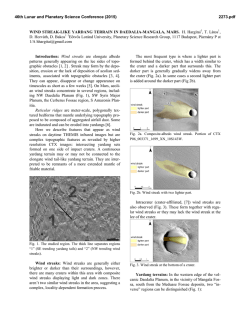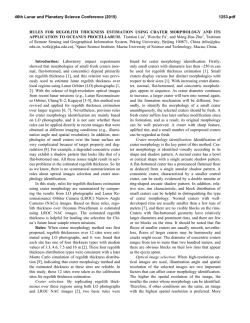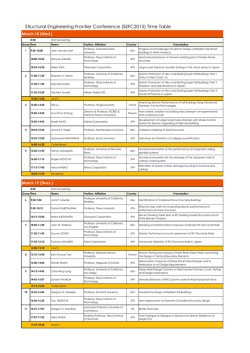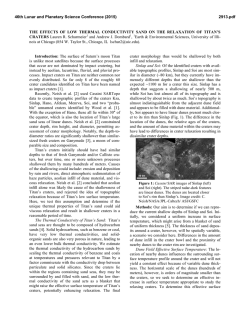
Predicted Seismic Signatures of Recent Dated Martian Impact Events
46th Lunar and Planetary Science Conference (2015) 2679.pdf PREDICTED SEISMIC SIGNATURES OF RECENT DATED MARTIAN IMPACT EVENTS: IMPLICATIONS FOR THE INSIGHT LANDER. M.E. Banks1,2, I.J. Daubar3, N.C. Schmerr4, M.P. Golombek3, 1 Planetary Science Institute, Tucson, AZ 85719, USA, 2Center for Earth and Planetary Studies, Smithsonian Air and Space Museum, Washington, DC 20013, USA, 3Jet Propulsion Laboratory, California Institute of Technology, Pasadena, CA 91109 USA, 4University of Maryland, Department of Geology, College Park MD 20742 USA. Introduction: Impact events are key sources of seismic waves for geophysical missions. Seismic waves provide invaluable information and constraints on the detailed internal structure and therefore formation, evolution, and dynamics of planets and satellites. Fresh craters formed by new impact events on Mars have been identified in before and after highresolution orbital images of the Martian surface [1-2]. This technique facilitates measurements of the exact position and size of impacts detected by a seismometer, and enables calibration of Martian seismic velocities and retrieval of internal structure from future missions, particularly the NASA Discovery Program lander InSight [3]. We investigate the potential impact-produced seismic activity from recent, dated impact events on Mars [e.g., 1, 4] through a detailed characterization of crater morphometry, and spatial information for clusters of new craters. Crater morphometry and locations are used to model the expected seismic response of Mars to actual recent impact events, and evaluate the detectability at different distances of an impact for various body and surface wave phases. The unique approach of this ongoing project builds upon previous theoretical and experimental characterizations of impacts [e.g., 5]. Results will be directly relevant for developing techniques to recover Martian internal structure from single 3-component seismometers, such as the Seismic Experiment for Interior Structure (SEIS) on InSight. Data and Methods: Crater Measurements. Images from the High Resolution Imaging Science Experiment (HiRISE) [6] on Mars Reconnaissance Orbiter (MRO), with pixel scales of 0.25 m/pixel, are used to investigate new, dated impact sites. High-resolution views have revealed that new martian impacts occur as both single craters and clusters of multiple craters (about 56% clusters) [2]. Crater diameters range from below HiRISE resolution up to tens of meters [2]. For this preliminary study, four new impact sites [4, 7] were chosen to include a variety of types of impacts (single craters and clusters), and which are located at varying distances from the proposed InSight landing area (see Table; Fig. 1). Each crater diameter was measured, along with the crater’s center latitude and longitude to establish dispersion within clusters. Where possible, it was noted if a crater appears to have a flat floor or a concentric/“nested” morphology (e.g. Fig. 1D) which would indicate excavation into a layered target where more consolidated material (e.g., Fig Lon (°E) 135.254 Description 1A Lat (°N) 4.283 1B -1.343 141.566 1C -6.629 156.446 1D 25.846 247.617 cluster of ~3 craters; diameters: ~1 to 4.6 m cluster of ~6 craters; diameters: ~1 to 6 m cluster of >100 craters; diameters up to ~4.5 m Single crater; diameter=~5.4 m Proximity to InSight Within ellipses (E09, E17) Within ellipse (E15) ~1300 km ~6000 km Figure 1. New dated impact sites used for this study (see table). HiRISE observation IDs are indicated. For all: North is up; sun is roughly to the west. A and B are enhanced false color RDRs; C and D are red RDRs. Lower panels show predicted seismograms at different distances calculated using properties measured from craters; clustered impacts are spread artificially over 2 seconds (initial upper bound estimate, likely too high) to simulate non-simultaneous impact. Image credit: NASA/JPL/University of Arizona. ice or, more likely at the latitudes in this study, bedrock), underlies more unconsolidated material (e.g., regolith or loose sediments). For all but the largest cluster, craters either had apparently parabolic floors or the shape of the floor could not be clearly determined. For the largest cluster (Fig. 1D), several of the larger craters >2 m in diameter appear to have flat floors, and 46th Lunar and Planetary Science Conference (2015) some craters >3.5 m in diameter appear to have floors with concentric or “nested” morphologies indicating excavation into a subsurface layer of more consolidated material. This is consistent with evidence for a surface layer of unconsolidated regolith at the InSight landing sites based on the onset diameter of craters with rocky ejecta [8]. Seismic Modeling. Measured crater parameters and a range of target material constraints are used to inform elastic wave propagation simulations for assessing the detectability of impact seismic energy sampling the Martian interior. The seismic modeling involves 3 stages: 1) crater characteristics and end-member models of target properties are used to scale the amount of impact energy translated from the bolide into seismic energy within Mars. 2) The size and locations of nearcontemporaneous clustered impact craters and singular impacts are used to construct source time functions for each impact (Fig. 1). 3) The resulting sources are then convolved with Green’s functions produced for elastic models of attenuation and surface material properties (Fig. 2). The resulting seismic amplitudes are finally used to evaluate the detectability at distance of an impact for various body and surface wave phases (Fig. 3). To better inform the seismic modeling, a set of target materials is used for converting to seismic efficiencies and attenuation factors. For the purposes of this study, the most influential target properties are the differences between unconsolidated material versus consolidated materials, and/or a combination of consolidated materials superposed by a layer of unconsolidated material with a range of appropriate layer thicknesses. We use an end-member approach assigning seismic efficiencies of η=10-2 to bedrock, and η=10-6 to regolith [e.g. 9] (Fig. 2). This range of target properties is relevant to the majority of materials on the surface of Mars, and is especially relevant for western Elysium Planitia, the proposed landing site for InSight. [e.g. 10]. Results: For a range of target properties (bedrock vs. regolith), we calculate that the individually observed impacts would have generated seismic events with moment magnitudes between -2.3 to 2.2 [5], (Fig. 2). Impacts with magnitudes > 0.5 are within the detectability of the InSight SEIS instrument [7]. For clustered impacts, we investigated the effect of a distributed source function on using the Serpentine Wave Propagation Package [11] to model impacts in 3-D (Fig. 3). The resultant sourcetime function is dependent upon the total moment release of the multiple impacts, time of impact events, and geographic closeness of the clustered impacts. Smaller craters contribute significantly less energy to the source function, but add to the complexity of recorded seismic energies (Fig. 1). 2679.pdf Figure 2. Predicted seismic amplitudes for the crater sizes detected in our study (0.2-5.4 m). Shaded fields indicate ranges of amplitude for impacts into hard rock (η=10-2), soft rock (η=10-4), and regolith (η=10-6). Figure 3. Map of the predicted signal noise for to (SNR) impacts (white dots) located near InSight landing ellipses (out- lined in white). Labels are as in Fig. 1. SNR is calculated using soft rock (η=10-4), and an average background noise amplitude of 1 nm s-1 Hz-1/2. As long as the sensitivity of SEIS exceeds the background noise of Mars, we predict that the impacts in Figs. 1A and 1B would have been detected by SEIS (assuming SEIS to be located in one of the landing ellipses shown in Fig. 3), while the impacts in Figs. 1C and 1D are too far away to have been detected. Other factors that influence detectability, and that will continue to be investigated, are attenuation, scattering, topography, and further variations in target properties. This ongoing study will predict potential observations by future seismic missions such as InSight, and place constraints on the forms and amplitudes of seismic signals initiated by new impacts. References: [1] Malin M.C. et al. (2006) Science, 314, 15731577. [2] Daubar I.J. et al. (2013) Icarus, 225, 506-516. [3] Banerdt B. et al. (2013) LPS XLIV, Abstract #1915. [4] Daubar I.J. et al. (2011) LPS XLII, Abstract #2232. [5] Teanby N.A. and Wookey J. (2011) Physics of the Earth and Planetary Interiors, 186, 70-80. [6] McEwen A.S. et al. (2007) JGR, doi:10.1029/2005JE002605112. [7] Schmerr N.C. et al. (2014) GSA, Abstract #259-12. [8] Warner N.H. et al. (2014) LPS XLV, Abstract #2217. [9] Ide S. and Beroza G.C. (2001) GRL, 28, 3349-3352. [10] Warner N.H. et al. (2014) LPS XLV, Abstract #1499. [11] Petersson, N.A. et al. (2010) Lawrence Livermore National Laboratory Technical Report LLNL-TR422928.
© Copyright 2025


